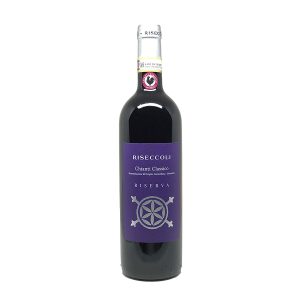Cabernet Sauvignon
Cabernet Sauvignon has a long history in Italian wines, being first introduced to the Piedmont region in 1820. In the mid-1970s, the grape earned notoriety and controversy as a component in the so-called “Super Tuscan” wines of Tuscany. Today the grape is permitted in several Denominazioni di origine controllata (DOCs) and is used in many Indicazione Geografica Tipica (IGT) wines that are made outside DOC perimeters in certain regions. For most of its history the grape has been viewed with suspicion as a “foreign influence” that distracts from the native grape varieties. After decades of experimentation, the general view of Cabernet Sauvignon has improved as more winemakers find ways to complement their native grape varieties with Cabernet as a blending component.
A Cabernet Sauvignon/Barbera blend from the Langhe DOC of Piedmont.
In Piedmont, the grape was sometimes used as an “illegal” blending partner with Nebbiolo for DOC classified Barolo with the intention of adding color and more fruit flavors. In the DOCs of Langhe and Monferrato, Cabernet is a permitted blending grape with Nebbiolo as well as Barbera. Wines that are composed of all three grape varieties are often subjected to considerable oak treatment to add a sense of sweet spiciness to compensate for the high tannins of Cabernet Sauvignon and Nebbiolo as well as the high acidity of Barbera. There are varietal styles of Cabernet Sauvignon produce in Piedmont with qualities varying depending on the location. In other regions of northern Italy, such as Lombardy, Emilia-Romagna and Friuli-Venezia Giulia, the grape is often blended with Merlot to produce Bordeaux style blends. In the Veneto region, Cabernet Sauvignon is sometimes blended with the main grapes of Valpolicella-Corvina, Molinara and Rondinella. In southern Italy, the grape is mostly used as a blending component with local varieties-such as Carignan in Sardinia, Nero d’Avola in Sicily, Aglianico in Campania and Gaglioppo in Calabria.
Cabernet Sauvignon has had a controversial history in Tuscan wine, particularly for its role in the arrivals of “Super Tuscan” in the mid-1970s. The origin of Super Tuscans is rooted in the restrictive DOC practices of the Chianti zone prior to the 1990s. During this time Chianti could be composed of no more than 70% Sangiovese and had to include at least 10% of one of the local white wine grapes. Many Tuscan wine producers thought they could produce a better quality wine if they were not hindered by the DOC regulations, particularly if they had the freedom to use Cabernet Sauvignon in the blend and not required to use white grape varieties. The marchese Piero Antinori was one of the first to create a “Chianti-style” wine that ignored the DOC regulations, releasing a 1971 Sangiovese-Cabernet Sauvignon blend known as Tignanello in 1978. Other producers followed suit and soon the prices for these Super Tuscans were consistently beating the prices of some of the most well known Chianti. Other Tuscan wine regions followed suit, blending Cabernet Sauvignon with Sangiovese and even making varietal versions of the grape. Gradually the DOC system caught on and began allowing more regions to use the grape in their DOC designated wines. Cabernet Sauvignon in Tuscany is characterized by ripe black cherry flavors that can give a perception of sweetness as well as strong notes of blackcurrant. The wines typically reach an alcohol level around 14% but can still maintain notable levels of acidity. When blended with Sangiovese in significant quantities, Cabernet Sauvignon can dominate the blend with most Tuscan producers aiming to find a particular balance that suits their desired style.
Showing all 3 results
-
Red Wine 紅酒
Cielo e Terra, Casa Defra’, Cabernet Sauvignon D.O.C. 2023/2024
Original price was: $94.0.$90.0Current price is: $90.0. Add to cart -
Red Wine 紅酒
Riseccoli, Chianti Classico Riserva D.O.C.G. 2017/2020
Original price was: $431.0.$364.0Current price is: $364.0. Add to cart -
Red Wine 紅酒
Riseccoli, Saeculum, Toscana I.G.T. 2015
Original price was: $529.0.$476.0Current price is: $476.0. Add to cart



